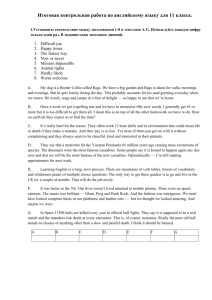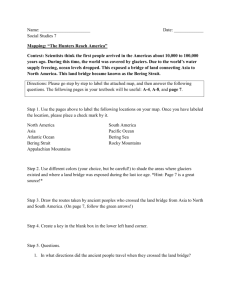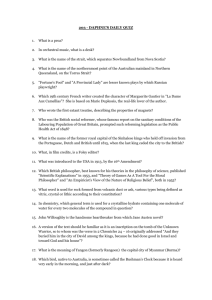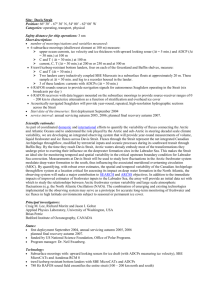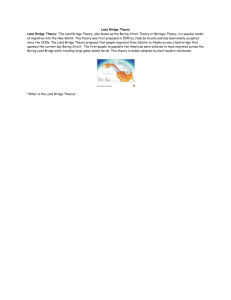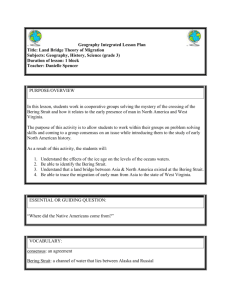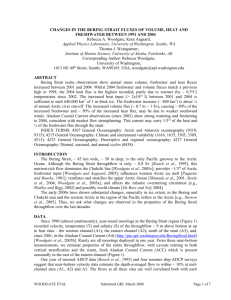RebeccaWoodgateBering
advertisement
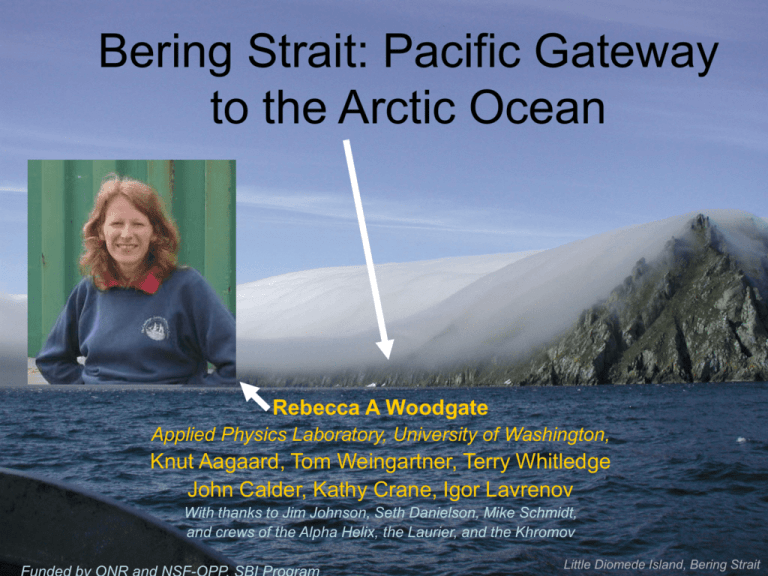
Bering Strait: Pacific Gateway to the Arctic Ocean Rebecca A Woodgate Applied Physics Laboratory, University of Washington, Knut Aagaard, Tom Weingartner, Terry Whitledge John Calder, Kathy Crane, Igor Lavrenov With thanks to Jim Johnson, Seth Danielson, Mike Schmidt, and crews of the Alpha Helix, the Laurier, and the Khromov 1 Little Diomede Island, Bering Strait Bering Strait: Pacific Gateway to the Arctic Ocean BERING STRAIT BASICS - why? how? what? RECENT RESULTS - seasonal variability - freshwater fluxes - interannual variability Little Diomede Island, Bering Strait CURRENT/FUTURE WORK - heat fluxes - an intensive observing system for IPY? 2 Bering Strait Basics The only Pacific gateway to the Arctic Ocean ~ 85 km wide ~ 50 m deep -divided into 2 channels by the Diomede Islands - split by the USRussian border -dominates the water properties of the Chukchi Sea - is an integrator of the properties of the Bering Sea (Coachman et al, 1975; Woodgate et al, 2005) -ice covered from ~ January to April Why does a little Strait matter so much? - annual mean northward flow ~0.8 Sv 3 Bering Strait dominates the Chukchi Sea Woodgate et al., 2005, DSR and via http://psc.apl.washington.edu/HLD Bering Strait good proxy of Arctic inflow 4 The role of Pacific waters in the Arctic Important for Marine Life Pacific waters are the most nutrient-rich waters entering the Arctic (Walsh et al, 1989) Implicated in the seasonal melt-back of ice In summer, Pacific waters are a source of near-surface heat to the Arctic (Paquette & Bourke, 1981; Ahlnäs & Garrison, 1984) Significant part of Arctic Freshwater Budget Bering Strait throughflow ~ 1/3rd of Arctic Freshwater (Wijffels et al, 1992; Aagaard & Carmack, 1989; Woodgate & Aagaard, 2005) Important for Arctic Stratification In winter, Pacific waters (fresher than Atlantic waters) form a cold (halocline) layer, which insulates the ice from the warm Atlantic water beneath (Shimada et al, 2001, Steele et al, 2004) 5 Global role of Bering Strait A Freshwater source for the Atlantic Ocean Pacific waters exit the Arctic through the Fram Strait and through the Canadian Archipelago Broecker, 1991 (Jones et al, 2003) Freshwater inhibits deep convection, slowing the Atlantic Ocean overturning circulation (see Wadley & Bigg, 2002, for a discussion) Models suggest the Bering Strait throughflow also influences the deep western boundary currents & the Gulf stream separation (Huang & Schmidt, 1993) 6 Paleo role of Bering Strait Stabilizer for World Climate? (DeBoer & Nof, 2004; Hu & Meehl, 2005) - if Bering Strait is open, excess freshwater in the Atlantic (from, for example, ice sheet collapse) can “vent” through the Bering Strait, allowing a speedy return to deep convection in the Atlantic. Land Bridge for migration of mammals and people? www.debbiemilleralaska.com Note: in modern times, people have swum, driven and walked across! 7 Special Observational Challenges of Bering Strait Two boundary currents - Alaskan Coastal Current (ACC) in the east present from ~ spring to midwinter (Paquette & Bourke, 1974) - Siberian Coastal Current (SCC) present seasonally in some years in the west - shallow (50 m), but covered by ice (keels to 20 m) from ~ January to April - stratified in spring/summer - split by the USRussian border (Weingartner et al, 1999) Eastern Bering Strait in Winter 8 Long-term moorings in Bering Strait From 1990 to present T, S and velocity at 9m above bottom A1 = western Channel A2 = eastern Channel A3 = combination of A1/2 A3’ (up north) A4 = Alaskan Coastal Current Not all moorings are deployed all years! Sea Surface Temperature 26th August 2004, from MODIS/Aqua level 1 courtesy of Ocean Color Data Processing Archive, NASA/Goddard Space Flight Center, thanks to Mike Schmidt Grey arrow marks the Diomede Islands (Little and Big Diomede). Russian EEZ line passes between the islands. 9 Moorings in Bering Strait Short (~20 m) long bottom moored Top float at ~40 m or deeper to avoid ice keels and barges STANDARD MEASUREMENTS = Temperature and salinity and velocity at 9 m above bottom (SBE16, and Aanderaa RCM7 and RCM9/11 due to biofouling) EXTRA MEASUREMENTS = ADCP - water velocity in 2 m bins from ~15 m above bottom to near surface - ice motion and rough ice thickness = ULS – upward looking sonars (good ice thickness) = NAS – Nutrient sampler = SBE16+ - Fluorescence, transmissivity, and PAR 10 CTD cruises e.g. Bering Strait & Chukchi Sea 2003 5-7 day Physical Oceanography Cruise - CTD and ship’s ADCP sections - sampling nutrients, O18, (productivity, CDOM, ...) - underway data and ship’s ADCP R/V Alpha Helix Seward. AK Photo from akbrian.net 11 Bering Strait 2004 Moorings and CTD work show temperature, salinity and velocity structure changes rapidly and on small space scales. To resolve the physics, we use: - high spatial resolution (here ~ 3km) - high temporal resolution (line run in ~4 hrs) - ship’s ADCP data 1st Sept 2004 5th Sept 2004 12 Getting the 4-dimensional picture Bering Strait and Chukchi Sea 2003 23rd June 2003 Convention line Fluorescence Chlorophyll from SeaWifs Satellite from NASA/Goddard Space Flight Center & Orbimage 5th – 7th July 2003 Sea surface temperature and altimeter satellite data too 13 http://psc.apl.washington.edu/BeringStrait.html 14 Bering Strait Basics - annual mean flow ~0.8 Sv northwards, with an annual (monthly mean) cycle of 0.3 to 1.3 Sv - weekly flow reversals common (-2 Sv to +3 Sv) -1 hourly flow can be over 100 cm/s - Alaskan Coastal Current (ACC) velocities can be 50-100 cm/s stronger than midchannel flow - flow strongly rectilinear - tides are weak (Roach et al, 1995; Woodgate et al, 2005) - away from boundary currents, flow dominantly barotropic (Roach et al, 1995) - flow in east and west channel highly correlated (0.95, Woodgate et al, 2005, DSR) 15 What Drives the Bering Strait Throughflow? Velocity = “Pacific-Arctic Pressure Head” + “Wind Effects” Mean=northward 10-6 sea surface slope gives rise to pressure gradient between Pacific and Arctic Oceans (Coachman & Aagaard, 1966; Stigebrandt, 1984) Mean=northward Mean=southward - across-strait atmospheric pressure gradient (Coachman & Aagaard, 1981) - local wind (Aagaard et al, 1985 and others) - set-up against topography (same ref) Wind explains ca. 60 % of the variance and the seasonal cycle (Roach et al, 95) But WHY? - freshwater transport from Atlantic by atmosphere? - steric height difference? - global winds? (Nof) In the mean, the winds oppose the pressure head forcing. Thus, in winter, when winds are strongest, the northward flow is weakest. ASSUMED constant - but why should it be? (Woodgate et al, 2005 DSR) AUG APRIL Woodgate et al, 2005 16 Reconstructing the velocity field (e.g. Woodgate et al, 2005 GRL) Assume Flow = “Pressure head” + const x (Wind) (Colours = real data; black=reconstruction) Reconstruction generally good but tends to miss extreme flow events, especially summer 1994. Linear fit to the wind better than a “climatology” But still we don’t really know the mechanism 17 Seasonal cycle in water properties (Woodgate et al, 2005) 3 2 SALINITY 31.9 to 33 psu 1 ICE 4 TEMPERATURE -1.8 to 2.3 deg C TRANSPORT 0.4 to 1.2 Sv (30 day means) AUG APRIL WHY CARE? (1) Maximum temperature in late Seasonally varying summer input to the Arctic Ocean (2) Autumn cooling and freshing, as - temperature overlying layers - salinity mixed down -volume (3) Winter at freezing point, - equilibrium depth salinisation due to (~50m in summer ice formation ~120m in winter) (4) Spring -nutrient loading freshening (due to ice melt) and then warming 18 Influence of shelf waters Along the Chukchi Shelf, upwelling and diapycnal mixing of lower halocline waters and Pacific waters Use silicate to track Pacific Water in the Chukchi Borderland (Note ventilation by polynya waters couldn’t give this T-S structure) Atl Pac Pacific Nutrient Max Woodgate et al, 2005 19 Bering Strait and Arctic Freshwater Aagaard & Carmack, 1989 (AC89) BERING STRAIT ~ 0.8 Sv (moorings) ~32.5 psu (summer 1960s/70s) Freshwater Flux relative to 34.8 psu ~ 1670 km3/yr P-E OTHER INPUTS Runoff = 3300 km3/yr P-E = 900 km3/yr + ... OTHER OUTPUTS Fram Strait water = 820 km3/yr Fram Strait ice = 2790 km3/yr Canadian Archipelago = 920 km3/yr + ... 20 The Alaskan Coastal Current (ACC) Summer Observations 10km wide, 40m deep, wedge-shape Summer ACC Volume flux 0.2 Sv (cf Bering Strait annual 0.8 Sv, weekly -2 to +3 Sv) Estimate salinity at 30 psu Summer ACC Freshwater flux 0.03 Sv (~900 km3/yr) But only present ca. April - December Sea Surface Temperature 26th August 2004, from MODIS/Aqua level 1, courtesy of Ocean Color Data Processing Archive, NASA/Goddard Space Flight Center, thanks to Mike Schmidt Salinity July 2003 from the Diomede Islands (left) to the Alaskan Coast (right) 21 The Alaskan Coastal Current July 2002-2003 VELOCITY NORTH A2 bottom central eastern channel 47m A4 the Alaskan Coastal Current 34m, 24m, 14m SALINITY A2 bottom central eastern channel 48m A4 the Alaskan Coastal Current 39m Black solid line = temperatures at freezing ACC annual mean velocity 40 cm/s; transport 0.08 Sv, salinity 30.3 psu Annual Mean Freshwater Flux 220-450 km3/yr (~ 20% AC89 Bering Strait) surface currents ~ 170 cm/s (at depth 70 cm/s) across-strait salinity gradient of ~ 3 psu present until late December 2002 (JD365), returns late April 2003 (JD480) 22 Put it together (with stratification and ice) Summer Stratification Chukchi~ 2 layer system, with salinity step of ~ 1 psu Assume stratified 6 months, ~350 km3/yr Ice Transport - annual mean NORTHWARD ice flux of 130 ± 90 km3/yr (despite almost 2 months of net southward ice flux) Total ~ 400 km3/yr (~20% of AC89 estimate) Salinity July 2003 from Little Diomede (left) to the Alaskan Coast (right) Annual Mean Freshwater flux = Previous estimate AC89 1670 km3/yr + ~ 400 km3/yr (Alaskan Coastal Current) + ~ 400 km3/yr (stratification and ice) ~ 2500 ± 300 km3/yr (Woodgate & Aagaard, GRL, 2005) 23 The Bering Strait Freshwater Flux (Woodgate & Aagaard, 2005) S = near bottom annual mean salinity FW = freshwater flux assuming no horizontal or vertical stratification FW+ = revised flux, including estimate of Alaskan Coastal Current and seasonal stratification Annual Mean Freshwater Flux ~ 2500 ± 300 km3/yr including ~ 400 km3/yr (Alaskan Coastal Current) ~ 400 km3/yr (stratification and ice) Interannual variability (from near bottom measurements) smaller than errors, although possible freshening ~ 1/3rd of Arctic Freshwater Arctic Rivers ~ 3300 km3/yr P-E ~ 900 km3/yr Fram Strait water & ice ~ 820 km3/yr & ~ 2790 km3/yr Canadian Archipelago ~ 920 km3/yr since 2003-2004 24 Arctic Freshwater revised Serreze et al, JGR, in press INFLOW - Rivers 38% - Bering Strait 30% - P-E 24% OUTFLOW - CAA 35% - Fram St water 26% - Fram St ice 25% 25 Bering Strait properties from 1990 to present 26 NEW from this year’s data? ACC colder in 2005, but bottom waters warmer 2006 is not starting out colder even though the ice is unusually heavy 27 Interannual Variability (up to 2004) Warming since 2001 Increasing flow since 2001 (mostly attributable to changes in local wind) Woodgate et al, 2006, GRL 28 Scale of variability Extra heat since 2001 could melt an area 800km by 800km of 1m thick ice Transport change significant 0.7 Sv in 2001 1 Sv in 2005 2004 largest heat flux observed Increasing flow accounts for 80% of the freshwater and 50% of the heat flux increases Extra freshwater since 2001 is about ¼ of annual mean river run off BS heat flux is ~ 1/5 of Fram Strait heat flux Alaskan Coastal Current (ACC) carries ~ 10% of all freshwater entering the Arctic! ~ 1/4 Bering Strait FW ~ 1/3 Bering Strait heat STILL not properly measured Woodgate et al, 2006 29 Using MODIS to constrain the ACC (with Ron Lindsay) For - sea surface temperature (SST) - width of ACC - timing of ACC And thus heat flux, and maybe FW flux Black lines: weekly averages of eastern channel SST from MODIS 30 Bering Strait Future Plans Moorings and CTD work - NSF/NOAA proposal - US, Russian and Canadian work Altimeter and Satellite data - continue time-series measurements through and beyond IPY - improve vertical and horizontal moored resolution (especially for freshwater flux) - develop flow-proxies from wind/model/insitu/satellite data - design a monitoring network for the Bering Strait 31 IS full of surprises A trifloat after 14 months in the water North of the Diomedes, Sept 2004, large area of dead copepods http://psc.apl.washington.edu/AlphaHelix2004.html 32 The Pacific Arctic Gateway http://psc.apl.washington.edu/BeringStrait.html SEASONAL VARIABILITY – significant in T,S and volume INTERANNUAL VARIABILITY - very influenced by local wind - warming and freshening since 2001 - important part of Arctic FW and heat fluxes 3 2 1 ICE 4 FUTURE PLANS - heat flux with satellite data - intensive IPY array with upper layer TS measurements 33
